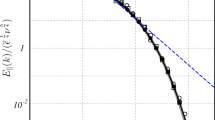Abstract
The flow in the far turbulent wake behind a body of revolution is studied with the use of a three-parameter turbulence model, which includes differential equations of the turbulent energy balance, transfer equation for the turbulent energy dissipation rate, and turbulent shear stress equation. Local equilibrium algebraic truncation of the transfer equation for the turbulent shear stress yields the known Kolmogorov–Prandtl relation. Under a certain restriction on the values of the empirical constants and for the law of time scale growth consistent with the mathematical model, this relation is a differential constraint of the model or an invariant manifold in the phase space of the corresponding dynamic system. The equivalence of the local equilibrium approximation and the condition of the zero value of Poisson’s bracket for the normalized turbulent diffusion coefficient and defect of the averaged streamwise component of velocity is demonstrated. Results of numerical experiments are reported; they are found to be in good agreement with theoretical predictions.


Similar content being viewed by others
REFERENCES
A. S. Ginevskii, Theory of Turbulent Jets and Wakes (Mashinostroenie, Moscow, 1969) [in Russian].
W. Rodi, “The Prediction of Free Turbulent Boundary Layers by Use of a Two-Equation Model of Turbulence," Ph.D. Dissertation (London, 1972).
V. I. Bukreev, O. F. Vasil’ev, and Yu. M. Lytkin, “Influences of the Shape of a Body on the Characteristics of a Selfsimilar Axisymmetric Wake," Dokl. Akad. Nauk SSSR 207 (4), 804–807 (1972) [Soviet Phys. Dokl. 17, 1144–1147 (1973)].
G. N. Abramovich, T. A. Girshovich, S. Yu. Krasheninnikov, et al., Theory of Turbulent Jets (Nauka, Moscow, 1984) [in Russian].
N. N. Fedorova and G. G. Chernykh, “On Numerical Modeling of Axisymmetric Turbulent Wakes," Model. Mekh. (collected scientific papers) 6 (3), 141–159 (1992).
V. E. Kozlov, “Self-Similar Solutions for an Axisymmetric Turbulent Wake," Prikl. Mekh. Tekh. Fiz. 36 (5), 16–20 (1995) [J. Appl. Mech. Tech. Phys. 36 (5), 654–657 (1995)].
J. Piquet, Turbulent Flows. Models and Physics (Springer-Verlaf, Berlin–Heidelberg, 1999).
O. V. Kaptsov, I. A. Efremov, and A. V. Shmidt, “Self-Similar Solutions of the Second-Order Model of the Far Turbulent Wake," Prikl. Mekh. Tekh. Fiz. 49 (2), 74–78 (2008) [J. Appl. Mech. Tech. Phys. 49 (2), 217–221 (2008)].
J. A. Redford, I. P. Castro, and G. N. Coleman, “On the Universality of Turbulent Axisymmetric Wakes," J. Fluid Mech. 710, 419–452 (2012).
A. G. Demenkov, O. A. Druzhinin, and G. G. Chernykh, “Numerical Models of a Far Turbulent Wake of an Elongated Body of Revolution," Teplofiz. Aeromekh. 23 (6), 967–970 (2016) [Thermophys. Aeromech. 23 (6), 929–932 (2016)].
W. Rodi, Turbulence Models and Their Application in Hydraulics. A State of the Art Review (Univ. of Karlsruhe, Karlsruhe, 1980).
A. F. Sidorov, V. P. Shapeev, and N. N. Yanenko, The Method of Differential Constraints and Its Applications in Gas Dynamics (Nauka, Novosibirsk, 1988) [in Russian].
V. K. Andreev, O. V. Kaptsov, V. V. Pukhnachev, and A. A. Rodionov, Applications of Group-Theoretical Methods in Hydrodynamics (Nauka, Novosibirsk, 1994; Springer, Netherlands, 1998).
V. N. Grebenev, A. G. Demenkov, and G. G. Chernykh, “Analysis of the Local-Equilibrium Approximation in the Problem of Far Planar Turbulent Wake," Dokl. Akad. Nauk 385 (1), 57–60 (2002) [Dokl. Phys. 47 (7), 518–521 (2002)].
V. N. Grebenev, A. G. Demenkov, G. G. Chernykh, and A. N. Grichkov, “Local Equilibrium Approximation in Free Turbulent Flows: Verification through the Method of Differential Constrains," Z. Angew. Math. Mech. 117 (9), e202000095 (2021).
V. N. Grebenev, A. G. Demenkov, and G. G. Chernykh, “Method of Differential Constraints: Local Equilibrium Approximation in a Planar Momentumless Turbulent Wake," Prikl. Mekh. Tekh. Fiz. 62 (3), 38–47 (2021) [J. Appl. Mech. Tech. Phys. 62 (3), 383–390 (2021)].
K. Hanjalic and B. E. Launder, “A Reynolds Stress Model of Turbulence and its Application to thin Shear Flows," J. Fluid Mech. 52, 609–638 (1972).
W. Lewellen, Handbook of Turbulence, Vol. 1: Fundamental and Applications (Plenum, New York, 1977).
Author information
Authors and Affiliations
Corresponding author
Additional information
Translated from Prikladnaya Mekhanika i Tekhnicheskaya Fizika, 2022, Vol. 63, No. 5, pp. 110-118. https://doi.org/10.15372/PMTF20220511.
Rights and permissions
About this article
Cite this article
Grebenev, V.N., Demenkov, A.G. & Chernykh, G.G. LOCAL EQUILIBRIUM APPROXIMATION IN THE MATHEMATICAL MODEL OF THE FAR TURBULENT WAKE BEHIND A BODY OF REVOLUTION. J Appl Mech Tech Phy 63, 825–832 (2022). https://doi.org/10.1134/S002189442205011X
Received:
Revised:
Accepted:
Published:
Issue Date:
DOI: https://doi.org/10.1134/S002189442205011X



